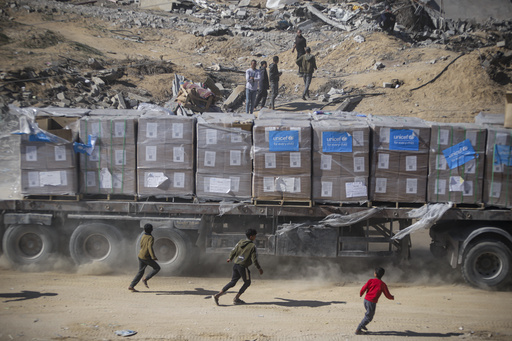
JERUSALEM — Following the establishment of a ceasefire between Hamas and Israel two weeks ago, humanitarian assistance is streaming into the Gaza Strip, providing much-needed aid to a region grappling with food shortages, widespread displacement, and the remnants of a prolonged conflict that has lasted 15 months. However, both Palestinians and aid organizations face significant hurdles in ensuring that help reaches those in need. Concerns about a potential return to combat remain prevalent as the six-week initial phase of the ceasefire draws closer to its conclusion.
Under the terms of the ceasefire, Israel committed to allowing an influx of 600 aid trucks into Gaza every day—an increase that has led to the entry of approximately 4,200 trucks weekly since the ceasefire began. Nevertheless, humanitarian groups report that the distribution of assistance is complicated by damaged infrastructure, meticulous Israeli inspections, and the constant threat posed by unexploded ordnance.
In Jabaliya, located in northern Gaza, 68-year-old Samir Abu Holi monitored a food distribution site in a neighborhood that has been devastated by several Israeli offensives, with the most recent severely limiting aid access for over a month. “I have more than 10 children. All of them need milk and food. Before the ceasefire, we struggled to provide food,” Abu Holi expressed. “Today there is a little relief.”
The recent influx of aid has been notable. The World Food Program, a principal U.N. food agency, reported distributing more food in the first four days of the ceasefire than it averaged in an entire month prior during the hostilities. Since the ceasefire’s implementation, over 32,000 metric tons of aid have entered Gaza, according to the agency’s latest figures.
Aid now flows through two crossings in the north and one in the south of Gaza. Organizations have initiated operations to open bakeries and distribute high-energy biscuits, while Hamas police are on the streets aiding in the restoration of order. Before the ceasefire, delivering aid was hindered by gangs robbing trucks, attacks on aid personnel, time-consuming Israeli inspections, and difficulties in coordinating with the Israeli military’s COGAT unit, which oversees aid facilitation. Israel has attributed aid distribution failures to the U.N. and other humanitarian groups once aid reached Gaza.
Tania Hary, the executive director of Gisha, an Israeli organization advocating for Palestinian freedom of movement, noted a positive shift in the political climate, stating, “COGAT is fast-tracking responses to coordination requests, allowing for two crossings to operate in the north. The ceasefire enables Hamas to maintain order and support for aid agencies that can now function more effectively.”
However, challenges persist regarding food affordability. Nadine Jomaa, a young woman residing in Bureij, a central Gaza locality, pointed out that although assistance exists, it is not always freely accessible, compelling her to buy goods on the market, where prices have skyrocketed due to reselling. While some prices are declining, key items like flour and cooking gas are still approximately three times their pre-war values, as reported by the World Food Program.
“We need more food, water, kitchen and bathroom supplies, as well as essentials for women,” Jomaa added, expressing her family’s reliance on cheaper canned goods. Many Palestinians, especially in the north, assert that the influx of aid to date has only fostered the emergence of shadowy intermediaries. Locals lament the scarcity of tents while non-essential items like snacks and soft drinks abound.
Ahmed Qamar, 34, who has returned to the rubble of his former home in Jabaliya, revealed the dire situation: “Hundreds of families here are sleeping outside in the cold,” he stated. “We need electricity and shelter, while markets are overflowing with chocolate and cigarettes.”
UNICEF spokesperson Tess Ingram noted that health officials still report malnutrition cases among children and pregnant women, revealing ongoing struggles for adequate nutrition. Although the Israeli inspection process has improved somewhat, certain types of aid remain difficult to get into Gaza. Many items face bans as they are classified as “dual-use,” raising concerns that militants could exploit them for military purposes.
Ongoing fuel shortages affect critical facilities like hospitals and desalination plants, with Hamas alleging that Israeli authorities are impeding medical supply and reconstruction machinery deliveries. According to a list shared with humanitarian groups by COGAT, essential items like storage units, tools, and shelter construction kits require prior approval to enter Gaza. Unrestricted items, such as large tents and vaccines, can be brought into the territory without prior Israeli clearance.
Despite the increase in aid, the pressure of restrictions on essential supplies remains evident. Ingram emphasized that the limited availability of generators and materials hinders efforts to repair Gaza’s damaged water infrastructure, leaving many without access to clean water and risking disease spread due to unsanitary conditions. In her visits to the severely impacted areas, including Jabaliya and Beit Lahiya, Ingram found residents “desperate for something to drink,” with many requesting water.
COGAT acknowledged the dual-use classification but stated they are still permitting specific items into Gaza after thorough screening. The agency further contended that tents are not classified as dual-use and confirmed that tens of thousands have entered Gaza recently without restrictions, alongside extended operational hours for crossings and road repairs inside Gaza.
The conflict has left numerous roads in tatters, and unexploded ordnance poses a significant danger. The U.N. estimates that 5% to 10% of all munitions deployed in Gaza have gone undetonated, creating hazards for civilians and humanitarian efforts. UNMAS, the U.N. agency responsible for dealing with unexploded munitions, has reported multiple instances of humanitarian convoys and civilians discovering large bombs and grenades since the ceasefire.
Jonathan Crickx, UNICEF’s chief of communications, shared his observations of families displaced and walking along roads in southern Gaza. “I saw so many children and families with nothing but the clothes on their backs,” he noted, highlighting the human cost of the ongoing crisis.

